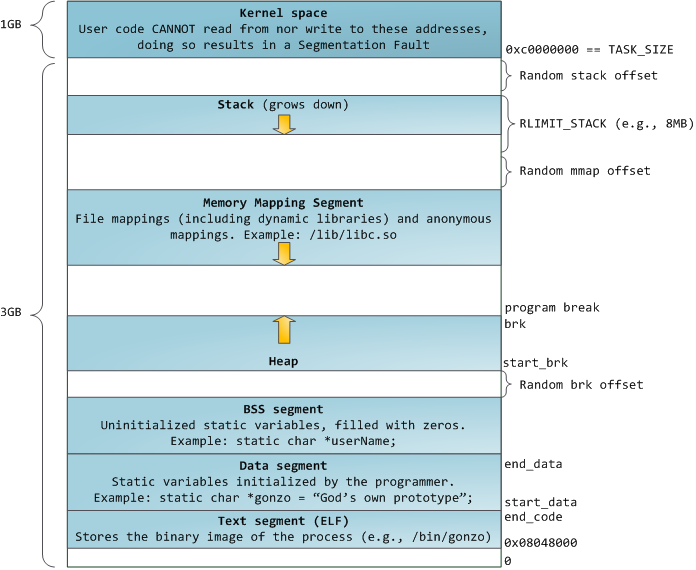Memory Allocator - Under The Hood
Memory Allocator in Different OS
Linux |
ptmalloc2 |
FreeBSD |
jemalloc |
System Call for Malloc
Testing
testing program :
// test_malloc.c
#include <stdio.h>
#include <stdlib.h>
int main() {
puts("===========");
free(malloc(sizeof(int)));
puts("===========");
return 0;
}
Linux
compile, execute, trace system call :
$ gcc test_malloc.c -o test_malloc
$ strace ./test_malloc # Linux
在 trace system call 時,
這邊觀察到兩個 system call,
brk(0) 和 brk(0x14e5000) (數值可能會不一樣),
所以我們可以確定的是,
在 Linux 上目前去 call malloc 時,
會用到 brk 這個 system call
FreeBSD
compile, execute, trace system call :
$ clang test_malloc.c -o test_malloc
$ truss ./test_malloc # FreeBSD
在 trace system call 時,
這邊只觀察到一個 system call,
可以發現使用的 system call 是 madvise ,
和 Linux 上不同 (Linux 上是 brk)。
madvise(0x2c07000,0x1000,0x5,0xaaaaaaaaaaaaaaab,0x2c00048,0x24c4be0) ,
這是用於 free 的
Explain
所以到底這些 system call (brk, madvise) 都做了些什麼勒?
為什麼 call 完後 heap 就會多出空間可以使用?
我們先來看看 Linux 上的 Memory 都放了些什麼東西 :

sbrk
sbrk 是 glibc 的 brk wrapper
glibc
glibc/misc/sbrk.c :
/* Extend the process's data space by INCREMENT.
If INCREMENT is negative, shrink data space by - INCREMENT.
Return start of new space allocated, or -1 for errors. */
void *
__sbrk (intptr_t increment)
{
void *oldbrk;
/* If this is not part of the dynamic library or the library is used
via dynamic loading in a statically linked program update
__curbrk from the kernel's brk value. That way two separate
instances of __brk and __sbrk can share the heap, returning
interleaved pieces of it. */
if (__curbrk == NULL || __libc_multiple_libcs)
if (__brk (0) < 0) /* Initialize the break. */
return (void *) -1;
if (increment == 0)
return __curbrk;
oldbrk = __curbrk;
if ((increment > 0
? ((uintptr_t) oldbrk + (uintptr_t) increment < (uintptr_t) oldbrk)
: ((uintptr_t) oldbrk < (uintptr_t) -increment))
|| __brk (oldbrk + increment) < 0)
return (void *) -1;
return oldbrk;
}
glibc/sysdeps/unix/sysv/linux/generic/brk.c
int
__brk (void *addr)
{
INTERNAL_SYSCALL_DECL (err);
__curbrk = (void *) INTERNAL_SYSCALL (brk, err, 1, addr);
if (__curbrk < addr)
{
__set_errno (ENOMEM);
return -1;
}
return 0;
}
glibc/sysdeps/unix/sysv/linux/x86_64/sysdep.h
# define INTERNAL_SYSCALL_NCS(name, err, nr, args...) \
({ \
unsigned long int resultvar; \
LOAD_ARGS_##nr (args) \
LOAD_REGS_##nr \
asm volatile ( \
"syscall\n\t" \
: "=a" (resultvar) \
: "0" (name) ASM_ARGS_##nr : "memory", "cc", "r11", "cx"); \
(long int) resultvar; })
# define INTERNAL_SYSCALL(name, err, nr, args...) \
INTERNAL_SYSCALL_NCS (__NR_##name, err, nr, ##args)
C - Inline Assembly
關鍵字 : asm
asm("movl %ecx %eax"); /* moves the contents of ecx to eax */
__asm__("movb %bh (%eax)"); /*moves the byte from bh to the memory pointed by eax */
asm 和 __asm__ 都可以用,當 asm 在程式中會 conflict 時就可以使用 __asm__ ,
如果 assembly code 有很多行的話,每行結尾加上 “nt”,
如此一來在把 assembly code 字串丟給後面的 as (ex: GAS (GNU Assembler)) 處理時,
格式才會是正確的。
asm ("movl %eax, %ebx\n\t"
"movl $56, %esi\n\t"
"movl %ecx, $label(%edx,%ebx,$4)\n\t"
"movb %ah, (%ebx)");
Extended Asm :
asm ( assembler template
: output operands /* optional */
: input operands /* optional */
: list of clobbered registers /* optional */
);
asm volatile (“syscallnt” : “=a” (result) : “0” (SYS_BRK) : “memory”, “cc”, “r11”, “cx”);
GCC 用 AT&T/UNIX assembly syntax
Source-Destination Ordering
“Op-code src dst”
Register Naming
prefix by %, %eax
Immediate Operand
Operand Size
Memory Operands
Intel Code |
AT&T Code |
mov eax,1 mov ebx,0ffh int 80h mov ebx, eax mov eax,[ecx] mov eax,[ebx+3] mov eax,[ebx+20h] add eax,[ebx+ecx*2h] lea eax,[ebx+ecx] sub eax,[ebx+ecx*4h-20h] |
movl $1,%eax movl $0xff,%ebx int $0x80 movl %eax, %ebx movl (%ecx),%eax movl 3(%ebx),%eax movl 0x20(%ebx),%eax addl (%ebx,%ecx,0x2),%eax leal (%ebx,%ecx),%eax subl -0x20(%ebx,%ecx,0x4),%eax |
Misc
brk 是什麼的縮寫?